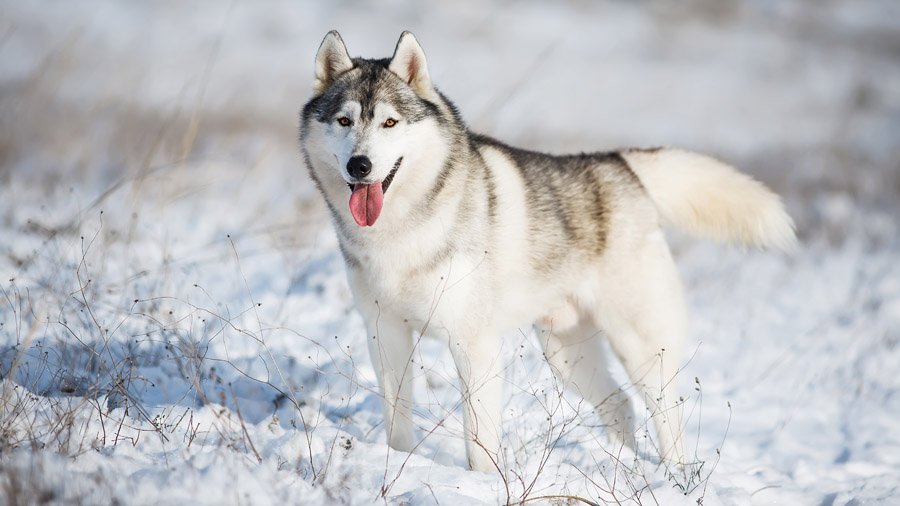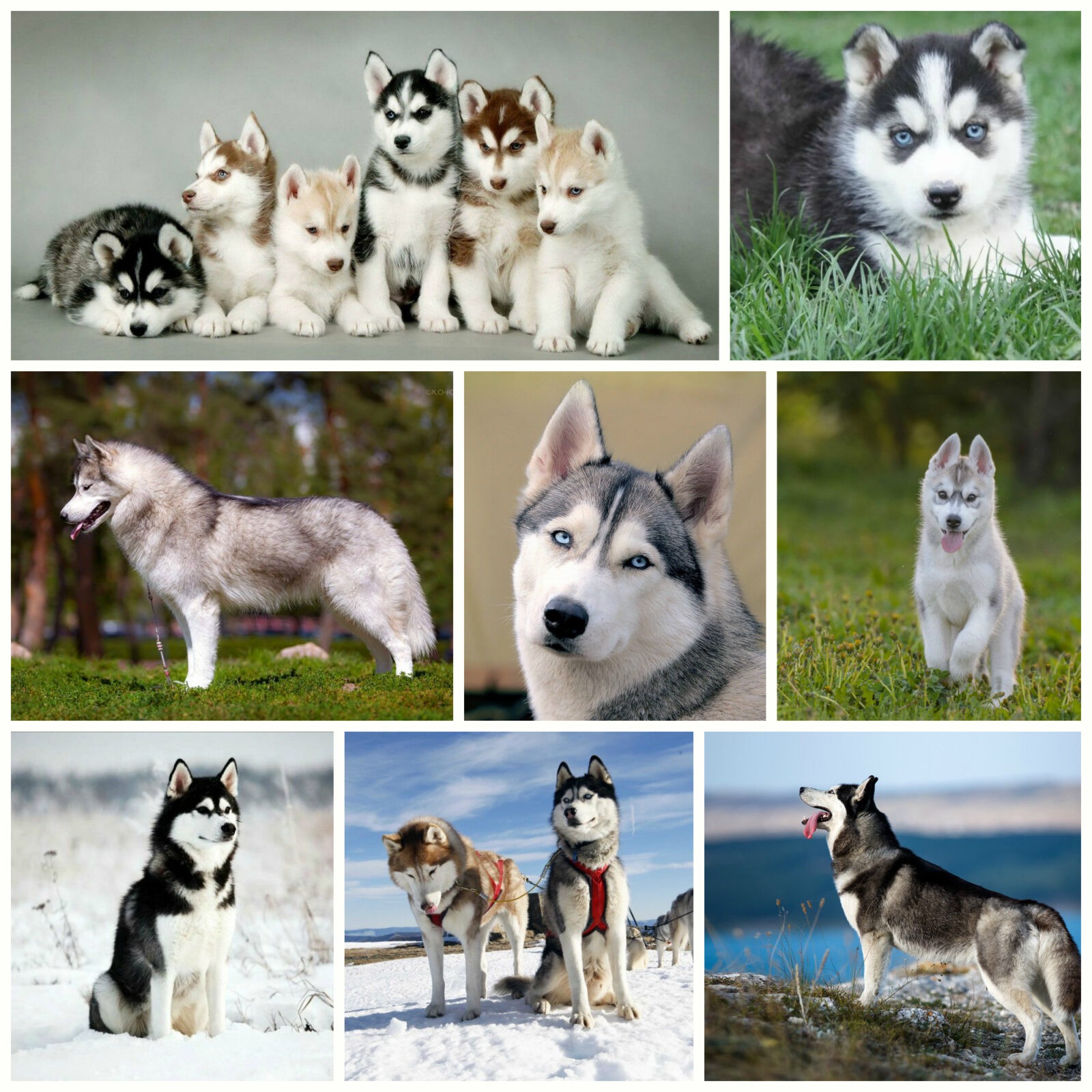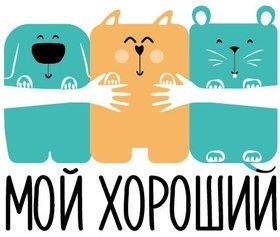Siberian Husky is the most beautiful dog breed with thick wool of various colors. Blue, sometimes multi-colored, the eyes of this dog fascinate with their beauty and penetration. The breed was bred in Siberia. The dog is very similar to the wolf. The animal is very active and extremely intelligent, belongs to the sports breeds.

Brief description of the breed
Husky Pros:
- Good friend for children;
- Ideal sled dog;
- Very temperamental;
- Smart;
- Friendly towards people;
- Doesn't bark;
- Easily tolerates a change of residence with the owner;
- Has no unpleasant smell.
Husky cons:
- Not suitable as a watchman;
- Does not have a protective instinct;
- Prefers to live in the company of dogs;
- Has a tendency to destruction;
- Can escape;
- Spoils the garden, digs holes;
- Does not tolerate heat well
- Poorly tolerates loneliness;
- Left alone, starts howl;
- Sheds a lot;
The Siberian Husky has conquered thousands of ordinary people around the world. Artists, writers, musicians, directors, who often sing of this breed in their works, did not stand aside either. This is not surprising. It is impossible not to fall in love with the bottomless eyes of this cute and affectionate dog.
The dog has medium sizes, refers to working breeds. It was bred as sled dogs. The ability of these amazing animals to learn is staggering. At the same time, the animal is quite stubborn, which is the main reason for the difficulties of training, for the success of which it is necessary to achieve the location and trust of the animal.
The breed is not designed for any dog breeder. Often the beauty of the animal becomes the reason why unprepared amateur dog breeders acquire it. At the same time, many do not know about the features of the complex nature of the animal. All this has led to an increase in the number of representatives of this breed in various shelters. Unprofessional training and ignorance of the basics of keeping Siberian huskies leads to the fact that the animal shows the worst traits of its character.
Having carefully considered all the positive aspects, you can be convinced of the real uniqueness of this breed. Siberian Huskies are smart and independent. They show tenderness and real warmth to loved ones. With great desire, the pet will spend time with the child, showing him attention and care.
Despite their sharp mind, the Siberian Husky is not easy to train. Therefore, the dog is suitable for experienced, self-confident dog breeders who have professionalism and boundless perseverance and patience.
A feature of the Siberian Husky is a tendency to run away from home. The pet, if possible, can run away from home to wander "free". This often causes death or injury to the animal. A must for a husky owner - constant control over the dog, fencing the yard with a reliable fence.
Despite the presence of certain factors that complicate the maintenance and upbringing of the husky, this breed remains popular, and rightfully surprising. If you are ready to make the most of strengthening, show perseverance and patience in education, then you can decide to buy this dog, which will become a true friend.
https://moyhoroshiy.ru/porody-i-otzyvy/sobaki/s-aliaski-no-ne-khaski-istoriia-aliaskinskogo-kli-kaia
basic information
| Breed name: | Siberian Husky |
| Country of origin: | Russia |
| The time of the birth of the breed: | early 20th century |
| Type of: | spitz and primitive breeds |
| The weight: | 16 - 28 kg |
| Height (height at the withers): | 50 - 60 cm |
| Life Expectancy: | 12 - 13 years old |
|
ICF classification:
|
Group 5, Section 1, Number 270 |
| Puppies price: | 230 – 1150 $ |
| Most popular nicknames: | list of nicknames for siberian husky |
Evaluation of the characteristics of the Siberian Husky breed
| Adaptability
(a definition meaning how easily a dog can adapt to changes in life) |
🐶🐶🐶🐶🐶 |
| Shedding level
(Level and frequency of hair loss in the animal) |
🐶🐶🐶🐶🐶 |
| Tenderness level
(The level and amount of tenderness and affection that the dog gives in return for attention to itself) |
🐶🐶🐶🐶🐶 |
| Exercise needs
(Dog's daytime activity level) |
🐶🐶🐶🐶 |
| Social need
(The required number of contacts of the dog with other animals, as well as people) |
🐶🐶🐶 |
| Apartment content
(A factor that determines the level of noise and other inconveniences that a dog can deliver to owners in relation to the size of the apartment to the size of the dog) |
🐶🐶 |
| Grooming
(The number of bathing, brushing, and the number of professional grooming sessions required for the dog) |
🐶🐶 |
| Friendliness in an unfamiliar environment
(Features of the behavior of a dog in a society with strangers or in an unfamiliar environment) |
🐶🐶🐶 |
| Tendency to bark
(Tendency to bark and its frequency and volume) |
🐶🐶🐶🐶 |
| Health issues
(Potential health status of the dog) |
🐶🐶🐶 |
| Territoriality
(The dog's tendency to protect his home, yard, or even his owner's car) |
🐶 |
| Friendliness to cats
(Tendency towards tolerance of cats and reduced expression of hunting instincts) |
🐶 |
| Intelligence
(The ability of the dog to think and solve emerging difficulties (not to be confused with learning!) |
🐶🐶🐶🐶🐶 |
| Education and training
(The level of difficulty in training the dog to perform certain actions) |
🐶 |
| Friendliness to children
(A factor that determines how friendly a dog is to children, whether he likes to play with them and tolerate some childish pranks) |
🐶🐶🐶🐶🐶 |
| Game activity
(The concept is determined by its very name, and, as a rule, is found in almost all dogs) |
🐶🐶🐶🐶 |
| Observation
(The ability of a dog to detect the presence of a stranger on its territory) |
🐶 |
| Friendliness to other dogs
(The tendency of the dog to find common language with his other relatives) |
🐶🐶🐶🐶🐶 |
Appearance of the Siberian Husky
The Husky is a medium-sized dog with a strong but not dense body structure. torso slightly elongated, rib cage set deep, not too wide, back straight and even, the back is slightly lowered down. Croup dogs are lean, narrower compared to the chest. Tail covered with a lot of hair, set below the line of the spine, lowered and hanging when resting, and only when the dog is excited, raised above the spine, like a saber. Forelimbs moderately spaced, parallel and straight. shoulder blades located at an angle elbows widely set. Hind limbs parallel, markedly bent. Paws oval, dense, covered with wool.
Neck proudly worn, arched, densely covered with hair, when running, the head is pushed forward, it seems that it is slightly ahead. Head in proportion to the body. Scull prominent, muzzle tapering towards the nose. Bridge of the nose straight from the skull to the tip of the nose. Lips close fitting, scissor bite. Eyes almond-shaped, slightly oblique, dark brown or blue. It is allowed, although not desirable, to have different eye colors. The ears are set high, triangular in shape, slightly rounded on the tassels. Densely covered with hair both inside and out.
The proportion and appearance of the torso are reflected in motor skills, speed and endurance. Huxies have a characteristic gait, so smooth and harmonious that it seems as if they are not making any effort to do so. It is precisely because of this that they ideally cope with the task of a sled dog, which is able to drag light loads at an average speed over long distances. Male Siberian Husky breeds are never dense, but females are slightly drier than them in physique, although by no means weaker physically. With proper care of the dog, strong and well-defined muscles are clearly visible on the body without traces of excess weight.
Wool
The coat of the Siberian Husky is two-layered, of medium length, the coat is very lush and thick. The undercoat is lush, soft and dense, the upper coat is straight, rather harsh and rather close-lying.
Siberian Husky color
There are completely different colors of Siberian Huskies, in the breed standard all colors are allowed from black or pure white, to dark chocolate with shades from red to gold. However, the most commonly seen colors are: black, gray, wolf, silver, red, chocolate or gold with white dots, and spotted. An arbitrary pattern on the head is also allowed, although most often the muzzle is painted white along with the front of the skull, and the rest can be painted in any of the above shades.
Photos of Siberian Huskies:

History of the Siberian Husky
It is believed that the Siberian Husky was bred in the nomadic tribes of the Chukchi. The history of the breed is not truly known, but DNA tests indicate that the breed is one of the oldest on the planet. It is known for sure that the Chukchi successfully used these dogs for sledding. Dogs for this people have become full members of the family. Often they slept with children, warming them with their warmth.
In 1908, the Siberian Husky was introduced to Alaska. There the animals were used as sled dogs. They were especially popular during the so-called. "gold rush". Quite often, huskies become participants in various competitions.
It is established that the Siberian Husky was last taken out of Siberia in 1930. When the Soviet government closed the borders, the export of the breed became impossible. At the same time, the pet continues to thrive in different parts of our planet. Despite the fact that the appearance of modern huskies is somewhat different from those that were companions of the Chukchi, the character of the dogs has not changed much.
The Siberian Husky was recognized by the American Kennel Club as a separate breed in 1930. Eight years later, the first club of lovers of this breed appeared in the States. It should be mentioned that already in 1939, following the USA, the Siberian Husky was also recognized by the Canadian Kennel Club.
The nature of the Siberian Husky
The Siberian Husky is by nature a very attentive, non-aggressive dog, so it is not suitable for the duties of a guard or watchman. They have earned their attention among millions of people due to their exotic appearance, because these dogs are very similar to a wolf. Huskies adore their owner, treat other animals with love, they are friendly to strangers. All these qualities make the Siberian Husky an excellent companion dog.
Dogs of this breed are very cheerful, every exit to the street is like the first time for them. Despite this, huskies are distinguished by great curiosity and energy. Such a dog is unlikely to suit beginners who have not kept dogs before. In order for the pet to meet all the expectations of its owner, it is necessary to spend a lot of effort and energy. You can learn more about the nature of the Siberian Husky here.
Maintenance and care
Siberian Husky - easy to care for and maintain, they do not have an unpleasant odor, and in general, these animals are very clean. In this regard, they can be compared with cats. That is why you need to bathe a husky only when such a need arises.
Huskies shed throughout the year. The most active molting period occurs twice a year. It is noteworthy that dogs that live in colder climates shed less than their counterparts from warmer regions. To prevent the spread of hair around the house, it is necessary to comb the pet at least once a week. During active molting, daily combing is necessary.
Check your pet's ears weekly. Make sure that there are no irritations and signs of an inflammatory process. It is better to treat the auricles with a solution prescribed by a veterinarian. To do this, you do not need to use cotton, it is better to take a special swab made of soft cloth.
To prevent the occurrence of tartar and inflammation of the gums, it is necessary to brush your dog's teeth every week. Monthly nail trimming will also be sufficient, however, if the nails are growing rapidly, it may be necessary to trim them more frequently.
Training and education of the Siberian Husky
As with all other breeds, Siberian Huskies require mandatory training and socialization. It would be useful to help a professional and train the dog in a special training class.
Many husky owners claim that their pets follow all the commands that the trainer gives in the classroom, but when they come home, the dog refuses to follow any of the commands. This is due to the fact that Huskies are stubborn and rather difficult to train, which is another good reason why beginners will not cope with Huskies.
Dogs of this breed require an assertive, self-confident owner. Often, animals manipulate an insecure owner, resorting to the help of their charming look. Therefore, all family members should be aware that the dog needs to be stricter (without aggression, of course), especially during the period of training and training.
Health and disease
The Siberian Husky tolerates bad climatic conditions very well, but it should be borne in mind that in a well-heated apartment, the dog can become pampered and lose its innate endurance. Huskies come from the North, so they can feel great in the garden, while curling up in the snow in a ball and falling asleep for a long time, to the great horror of their owners.
Of course, huskies are not made of steel, but remember that they are very resistant to frost conditions, but on one condition: if we do not spoil the natural structure of their coat. Never shorten your pet's coat, otherwise the coat will lose its insulating properties. After bathing, the dog must be completely dry before you let him outside, otherwise he may catch a cold. Unfortunately, drying after bathing takes a lot of time.
Dogs of this breed have absolutely no tendency to hip dysplasia, cases of this disease mainly concern dogs raised by pseudo-breeders who do not care if the puppy's parents have any disease. Real breeders usually do a lot of research beforehand to rule out the possibility of hereditary diseases such as hip dysplasia or progressive retinal atrophy. It is from such people that it is worth buying puppies.
Remember that you should not greatly force the active growth of the dog, you need to fully feed it, but at the same time, you should not overfeed it and allow it to gain excess weight. As a reminder, Huskies are very sensitive to a lack of zinc, which can cause skin problems that quickly resolve if you change your diet and replace it with a nutritious diet rich in essential nutrients.
Some interesting facts
- The size of the dog depends on the climate in which the animal lives. As a rule, this breed is undersized.
- The Siberian Husky is prone to molting, which occurs 2 times a year. If the pet is kept in a hot climate, then molting occurs more often.
- The Siberian Husky is not designed to be kept in an apartment, but if you are an experienced dog breeder, you can take a chance.
- Representatives of the breed often run away from home. The owner needs to securely fence his yard to prevent the possibility of the dog escaping. The fence should be high enough, while it must be placed up to half a meter deep.
- The Siberian Husky is quite destructive. In the house, the animal can gnaw and scratch various interior items or furniture, and on the street they love to dig holes.
- Dogs of this breed are unsuitable for protection. They do not like to bark, so they are unlikely to alert you to danger.
- This Siberian dog is not the best option for a dog breeder - newbie.
- Huskies are very good-natured and friendly towards children, but you should not leave the animal alone with them.
- Dogs of this breed are bred for life in difficult conditions, so they are not particularly picky. Experts say that the animal can do without food for quite a long time.
- Don't let your husky run without a leash, otherwise your pet will chase various small animals.
- Husky beauty - reason for its popularity, but the complexity of raising and keeping this dog should be taken into account before deciding to buy it.
- To become the owner of a healthy dog, purchase puppies only from trusted breeders who are well known to you or your loved ones.
We borrowed material from the wonderful site of our partners DOGCATFAN.COM about cats and dogs, the author dogcatfan
